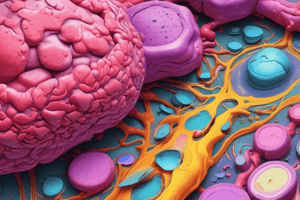Podcast
Questions and Answers
What type of diseases are caused by environmental factors?
What type of diseases are caused by environmental factors?
- Inflammatory
- Acquired (correct)
- Genetic
- Hemodynamic
Which classification is based on pathogenesis or disease mechanisms?
Which classification is based on pathogenesis or disease mechanisms?
- Congenital and inherited
- Inflammatory and hemodynamic
- Genetic and acquired (correct)
- Acquired and degenerative
What is the classification of diseases that are initiated before or during birth?
What is the classification of diseases that are initiated before or during birth?
- Acquired
- Degenerative
- Congenital (correct)
- Genetic
Which term refers to the initiator of the subsequent event resulting in a patient's illness?
Which term refers to the initiator of the subsequent event resulting in a patient's illness?
What is the mechanism by which cancer-causing agents result in the development of tumors?
What is the mechanism by which cancer-causing agents result in the development of tumors?
Which term refers to an aggregate of signs and symptoms without which a disease cannot be recognized or diagnosed?
Which term refers to an aggregate of signs and symptoms without which a disease cannot be recognized or diagnosed?
What refers to the anticipated outcome of a disease?
What refers to the anticipated outcome of a disease?
Which approach involves the study of disease in populations and the distribution of diseases in relation to place and time?
Which approach involves the study of disease in populations and the distribution of diseases in relation to place and time?
'A deterioration of cells or tissues in response to a variety of agents' describes which term?
'A deterioration of cells or tissues in response to a variety of agents' describes which term?
What does 'morbidity' refer to in epidemiology?
What does 'morbidity' refer to in epidemiology?
What is the purpose of a uniform nomenclature system in pathology and medicine?
What is the purpose of a uniform nomenclature system in pathology and medicine?
How can benign tumors be characterized?
How can benign tumors be characterized?
In disease nomenclature, what do eponymous names refer to?
In disease nomenclature, what do eponymous names refer to?
How are primary diseases defined?
How are primary diseases defined?
What is the main difference between acute and chronic diseases?
What is the main difference between acute and chronic diseases?
What is the fundamental purpose of disease classification?
What is the fundamental purpose of disease classification?
How are malignant tumors different from benign tumors?
How are malignant tumors different from benign tumors?
What is the definition of a disease according to the text?
What is the definition of a disease according to the text?
What is the key role of diagnosis in relation to disease classification?
What is the key role of diagnosis in relation to disease classification?
Which term refers to a disease that is a complication or manifestation of an underlying lesion?
Which term refers to a disease that is a complication or manifestation of an underlying lesion?
What is the main purpose of medicolegal autopsies?
What is the main purpose of medicolegal autopsies?
What is a common reason for performing clinical autopsies in hospitals?
What is a common reason for performing clinical autopsies in hospitals?
What percentage of cases reveal diagnostic discrepancies through autopsies?
What percentage of cases reveal diagnostic discrepancies through autopsies?
What happens if cells fail to meet the demand placed on them?
What happens if cells fail to meet the demand placed on them?
What are the morphological changes recognized as cell death?
What are the morphological changes recognized as cell death?
In which cases are clinical autopsies typically performed?
In which cases are clinical autopsies typically performed?
What is the outcome if cells are irreversibly injured?
What is the outcome if cells are irreversibly injured?
What is the consequence of cells failing to adapt to challenges?
What is the consequence of cells failing to adapt to challenges?
What is the main characteristic that distinguishes apoptosis from necrosis?
What is the main characteristic that distinguishes apoptosis from necrosis?
How does coagulative necrosis differ from liquefactive necrosis?
How does coagulative necrosis differ from liquefactive necrosis?
What is the key factor contributing to arterial thrombosis?
What is the key factor contributing to arterial thrombosis?
Which type of necrosis is most often associated with tuberculous infection?
Which type of necrosis is most often associated with tuberculous infection?
What distinguishes thrombosis from normal hemostasis?
What distinguishes thrombosis from normal hemostasis?
In apoptosis, what happens to the nucleus?
In apoptosis, what happens to the nucleus?
Which event triggers endothelial injury, a key predisposing factor for thrombosis?
Which event triggers endothelial injury, a key predisposing factor for thrombosis?
What are the morphological characteristics of reversible cell injury?
What are the morphological characteristics of reversible cell injury?
What happens to the mitochondria during apoptosis?
What happens to the mitochondria during apoptosis?
What is the characteristic feature of apoptotic cells that facilitates their removal by phagocytosis?
What is the characteristic feature of apoptotic cells that facilitates their removal by phagocytosis?
Study Notes
Autopsies and Cell Injury
- Autopsies can be performed for legal or medical purposes, revealing diagnostic discrepancies in around 30% of cases.
- There are two types of autopsies: medicolegal (to determine the cause of death, collect evidence, and perform forensic investigations) and clinical (to gather information on unclear diagnoses or hospital deaths).
Cellular Injury and Cell Death
- Cellular injury occurs when cells fail to adapt to challenges, resulting in changes or loss of function, and morphological changes.
- There are two types of cellular injury: reversible and irreversible.
- Irreversible cell injury leads to cell death, which can be classified into two main types: necrosis and apoptosis.
Mechanisms of Cell Injury
- Cell injury can result from various mechanisms, including:
- Oxygen-derived free radicals, which can cause lipid peroxidation, oxidative modification of proteins, and DNA damage.
- Functional and biochemical abnormalities in cellular components.
Consequences of Cell Injury
- Consequences of cell injury depend on the type, state, and adaptability of injured cells.
- Cellular response to stimuli depends on the type, severity, and duration of injury.
Necrosis and Apoptosis
- Necrosis: a pathological cellular or tissue death, resulting in a spectrum of morphological changes.
- Different types of necrosis include:
- Coagulative necrosis
- Liquefactive necrosis
- Caseous necrosis
- Fat necrosis
- Apoptosis: a programmed cell death, characterized by:
- Degradation of cytoskeletal framework
- Fragmentation of DNA
- Loss of mitochondrial function
- Nucleus shrinkage and fragmentation
- Cell shrinkage and phagocytosis
Thrombosis and Haemostasis
- Haemostasis: a normal process that maintains blood in a fluid, clot-free state in normal vessels.
- Thrombosis: a pathological process that forms a solid mass of blood constituents within the vascular system.
- Pathogenesis of thrombosis involves three predisposing factors:
- Endothelial injury
- Stasis or turbulence of blood flow
- Blood hypercoagulability
- Arterial thrombosis:
- High risk: prolonged bed rest, myocardial infarction, atrial fibrillation, prosthetic cardiac valves, tissue injury, surgery, fracture, burn, cancer, increased age
- Can cause ischemia and infarction
- Venous thrombosis:
- Mostly occurs in superficial or deep veins of the leg
- Can cause pulmonary infarction
- Can be asymptomatic
Nomenclature of Disease
- Classification of disease:
- Primary: disease without an apparent cause
- Secondary: disease as a complication or manifestation of some underlying lesion
- Acute and chronic: to describe the dynamics of a disease
- Benign and malignant tumors
- Eponymous names: disease or lesion named after a person or place associated with it
- Aims of disease classification:
- Determine the best treatment
- Estimate the prognosis
- Ascertain the cause
Disease Mechanisms
- Genetic diseases: due to abnormalities in the genome
- Acquired diseases: caused by environmental factors
- Congenital diseases: initiated before or during birth
- Acquired diseases: inflammation, hemodynamic disorders, growth disorders, injury, and disordered repair
- Aetiology: the initiator of the subsequent event resulting in the patient's illness
- Pathogenesis: the mechanism by which the aetiology operates to produce the pathological and clinical manifestations
Epidemiology
- The study of disease in populations and the distribution of diseases in relation to place and time
- Aims of epidemiology:
- Providing aetiological clues to the causes of disease
- Planning preventive measures
- Provision of adequate medical facilities
- Population screening for early diagnosis
Studying That Suits You
Use AI to generate personalized quizzes and flashcards to suit your learning preferences.
Description
Explore the system of names used in pathology and medicine to classify diseases. Learn about the importance of a uniform nomenclature system for communication and epidemiological studies. Understand the standard conventions, common terms, prefixes, and suffixes used in disease nomenclature.




